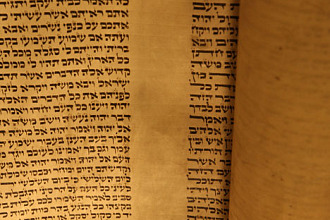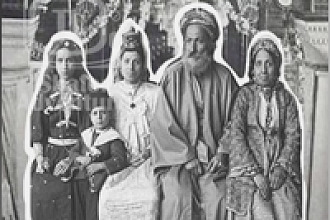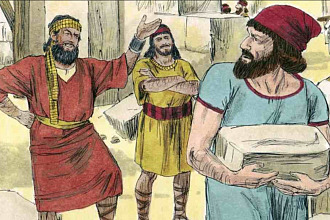Arabs sometimes claim that, as "Semites," they cannot possibly be antiSemitic. This, however, is a semantic distortion that ignores the reality of Arab discrimination and hostility toward Jews. Arabs, like any other people, can indeed be antiSemitic.The term "antiSemite" was coined in Germany in 1879 by Wilhelm Marrih to refer to the antiJewish manifestations of the period and to give Jewhatred a more scientific sounding name.(1) "AntiSemitism" has been accepted and understood to mean hatred of the Jewish people.
While Jewish communities in Arab and Islamic countries fared better overall than those in Christian lands in Europe, Jews were no strangers to persecution and humiliation among the Arabs and Muslim. As Princeton University historian Bernard Lewis has written: "The Golden Age of equal rights was a myth, and belief in it was a result, more than a cause, of Jewish sympathy for Islam."(2)
Muhammad, the founder of Islam, traveled to Medina in 622 A.D. to attract followers to his new faith. When the Jews of Medina refused to convert and rejected Muhammad, two of the major Jewish tribes were expelled; in 627, Muhammad's followers killed between 600 and 900 of the men, and divided the surviving Jewish women and children amongst themselves.(3)
The Muslim attitude toward Jews is reflected in various verses throughout the Koran, the holy book of the Islamic faith. "They [the Children of Israel] were consigned to humiliation and wretchedness. They brought the wrath of God upon themselves, and this because they used to deny God's signs and kill His Prophets unjustly and because they disobeyed and were transgressors" (Sura 2:61). According to the Koran, the Jews try to introduce corruption (5:64), have always been disobedient (5:78), and are enemies of Allah, the Prophet and the angels (2:9798).
The Dhimmi
Still, as "People of the Book," Jews (and Christians) are protected under Islamic law. The traditional concept of the "dhimma" ("writ of protection") was extended by Muslim conquerors to Christians and Jews in exchange for their subordination to the Muslims. Peoples subjected to Muslim rule usually had a choice between death and conversion, but Jews and Christians, who adhered to the Scriptures, were allowed as dhimmis (protected persons) to practice their faith. This "protection" did little, however, to insure that Jews and Christians were treated well by the Muslims. On the contrary, an integral aspect of the dhimma was that, being an infidel, he had to openly acknowledge the superiority of the true believer--the Muslim.
In the early years of the Islamic conquest, the "tribute" (or jizya), paid as a yearly poll tax, symbolized the subordination of the dhimmi. Later, the inferior status of Jews and Christians was reinforced through a series of regulations that governed the behavior of the dhimmi. Dhimmis, on pain of death, were forbidden to mock or criticize the Koran, Islam or Muhammad, to proselytize among Muslims or to touch a Muslim woman (though a Muslim man could take a nonMuslim as a wife).
Dhimmis were excluded from public office and armed service, and were forbidden to bear arms. They were not allowed to ride horses or camels, to build synagogues or churches taller than mosques, to construct houses higher than those of Muslims or to drink wine in public. They were not allowed to pray or mourn in loud voices-as that might offend the Muslims. The dhimmi had to show public deference toward Muslims-always yielding them the center of the road. The dhimmi was not allowed to give evidence in court against a Muslim, and his oath was unacceptable in an Islamic court. To defend himself, the dhimmi would have to purchase Muslim witnesses at great expense. This left the dhimmi with little legal recourse when harmed by a Muslim.(4)
Dhimmis were also forced to wear distinctive clothing. In the ninth century, for example, Baghdad's Caliph alMutawakkil designated a yellow badge for Jews, setting a precedent that would be followed centuries later in Nazi Germany.(5)
Violence Against Jews
At various times, Jews in Muslim lands were able to live in relative peace and thrive culturally and economically. The position of the Jews was never secure, however, and changes in the political or social climate would often lead to persecution, violence and death. Jews were generally viewed with contempt by their Muslim neighbors; peaceful coexistence between the two groups involved the subordination and degradation of the Jews.
When Jews were perceived as having achieved too comfortable a position in Islamic society, antiSemitism would surface, often with devastating results: On December 30, 1066, Joseph HaNagid, the Jewish vizier of Granada, Spain, was crucified by an Arab mob that proceeded to raze the Jewish quarter of the city and slaughter its 5,000 inhabitants. The riot was incited by Muslim preachers who had angrily objected to what they saw as inordinate Jewish political power.
Similarly, in 1465, Arab mobs in Fez slaughtered thousands of Jews, leaving only 11 alive, after a Jewish deputy vizier treated a Muslim woman in "an offensive manner." The killings touched off a wave of similar massacres throughout Morocco.(6)
Other mass murders of Jews in Arab lands occurred in Morocco in the 8th century, where whole communities were wiped out by Muslim ruler Idris I; North Africa in the 12th century, where the Almohads either forcibly converted or decimated several communities; Libya in 1785, where Ali Burzi Pasha murdered hundreds of Jews; Algiers, where Jews were massacred in 1805, 1815 and 1830 and Marrakesh, Morocco, where more than 300 hundred Jews were murdered between 1864 and 1880.(7)
Decrees ordering the destruction of synagogues were enacted in Egypt and Syria (1014, 12934, 13012), Iraq (854859, 1344) and Yemen (1676). Despite the Koran's prohibition, Jews were forced to convert to Islam or face death in Yemen (1165 and 1678), Morocco (1275, 1465 and 179092) and Baghdad (1333 and 1344).(8)
As distinguished Orientalist G.E. von Grunebaum has written:
It would not be difficult to put together the names of a very sizeable number of Jewish subjects or citizens of the Islamic area who have attained to high rank, to power, to great financial influence, to significant and recognized intellectual attainment; and the same could be done for Christians. But it would again not be difficult to compile a lengthy list of persecutions, arbitrary confiscations, attempted forced conversions, or pogroms.(9)
The situation of Jews in Arab lands reached a low point in the 19th century. Jews in most of North Africa (including Algeria, Tunisia, Egypt, Libya and Morocco) were forced to live in ghettos. In Morocco, which contained the largest Jewish community in the Islamic Diaspora, Jews were made to walk barefoot or wear shoes of straw when outside the ghetto. Even Muslim children participated in the degradation of Jews, by throwing stones at them or harassing them in other ways. The frequency of antiJewish violence increased, and many Jews were executed on charges of apostasy. Ritual murder accusations against the Jews became commonplace in the Ottoman Empire.(10)
By the twentieth century, the status of the dhimmi in Muslim lands had not significantly improved. H.E.W. Young, British Vice Consul in Mosul, wrote in 1909:
The attitude of the Muslims toward the Christians and the Jews is that of a master towards slaves, whom he treats with a certain lordly tolerance so long as they keep their place. Any sign of pretension to equality is promptly repressed.(11)
The danger for Jews became even greater as a showdown approached in the UN over partition in 1947. The Syrian delegate, Faris elKhouri, warned: "Unless the Palestine problem is settled, we shall have difficulty in protecting and safeguarding the Jews in the Arab world."(12)
More than a thousand Jews were killed in antiJewish rioting during the 1940's in Iraq, Libya, Egypt, Syria and Yemen.(13) This helped trigger the mass exodus of Jews from Arab countries.
Footnotes
1. Vamberto Morais, A Short History of Anti-Semitism, (NY: W.W Norton and Co., 1976), p. 11; Bernard Lewis, Semites & Anti-Semites, (NY: WW Norton & Co., 1986), p. 81.
2. Bernard Lewis, "The Pro-Islamic Jews," Judaism, (Fall 1968), p. 401.
3. Bat Ye'or, The Dhimmi, (NJ: Fairleigh Dickinson University Press, 1985), pp. 43-44.
4. Bat Yeor, pp. 30, 56-57; Louis Gardet, La Cite Musulmane: Vie sociale et politique, (Paris: Etudes musulmanes, 1954), p. 348.
5. Bat Yeor, pp. 185-86, 191, 194.
6. Norman Stillman, The Jews of Arab Lands, (PA: The Jewish Publication Society of America, 1979), pp. 59, 284.
7. Maurice Roumani, The Case of the Jews from Arab Countries: A Neglected Issue, (Tel Aviv: World Organization of Jews from Arab Countries, 1977), pp. 26-27.
8. Bat Ye'or, p. 61
9. G.E. Von Grunebaum, "Eastern Jewry Under Islam," Viator, (1971), p. 369.
10. Bernard Lewis, The Jews of Islam, (NJ: Princeton University Press, 1984) p. 158.
11. Middle Eastern Studies, (1971), p. 232.
12. New York Times, (February 19, 1947).
13. Roumani, pp. 30-31
Originally found here
Picture originally found here


























